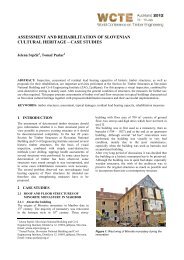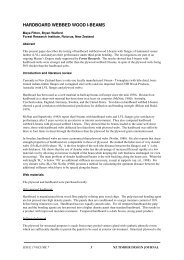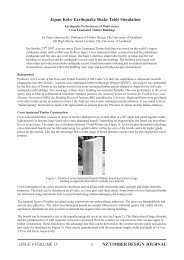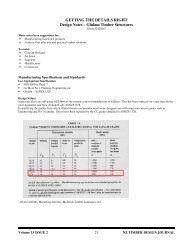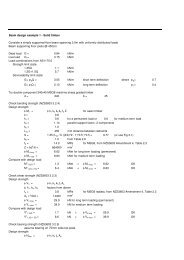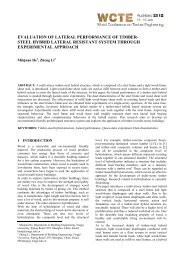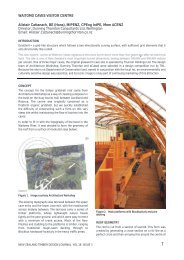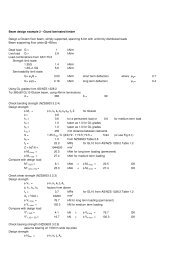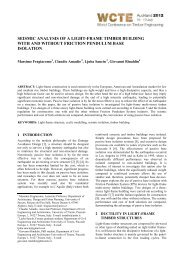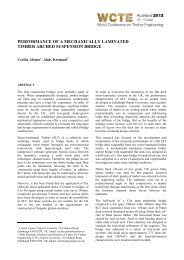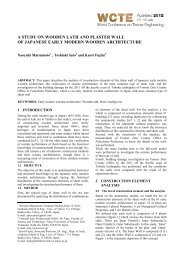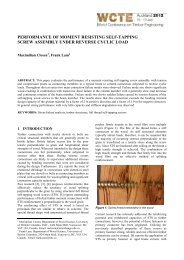00694 Pouyan Zarnani - Timber Design Society
00694 Pouyan Zarnani - Timber Design Society
00694 Pouyan Zarnani - Timber Design Society
Create successful ePaper yourself
Turn your PDF publications into a flip-book with our unique Google optimized e-Paper software.
LVL<br />
groups<br />
Rivet<br />
penetration<br />
Table 3: Strength and failure mode predictions using the proposed method<br />
compared to experimental results on LVL<br />
Proposed<br />
wood strength<br />
P w<br />
(kN)<br />
Rivet<br />
strength<br />
P r *<br />
(kN)<br />
t block<br />
(mm)<br />
Proposed/Observed<br />
Proposed<br />
wood<br />
strength P w<br />
(kN)<br />
Connection strength<br />
(prediction/test result)<br />
Mean<br />
ultimate<br />
load † Failure mode<br />
L p<br />
(mm)<br />
t block =t ef,e t block =t ef,y P u<br />
(kN)<br />
BRG1-L 28.5 314 "461" 27.1(t ef,e ) / 23 - 314/358 Brittle/Brittle<br />
BRG2-L 28.5 362 "461" 27.1(t ef,e ) / 27 - 362/370 Brittle/Brittle<br />
BRG3-L 28.5 380 "461" 27.1(t ef,e ) / 24 - 380/375 Brittle/Brittle<br />
BRG4-L 28.5 376 "461" 27.1(t ef,e ) / 21 - 376/391 Brittle/Brittle<br />
BRG5-L 28.5 381 "461" 27.1(t ef,e ) / 28 - 381/402 Brittle/Brittle<br />
BRG6-L 28.5 378 "461" 27.1(t ef,e ) / 26 - 378/410 Brittle/Brittle<br />
BRG7-L 28.5 391 "461" 27.1(t ef,e ) / 26 - 391/435 Brittle/Brittle<br />
BRG8-L 53.5 419 "692" 45.5(t ef,e ) / 48 - 419/463 Brittle/Brittle<br />
BRG9-L 53.5 392 "519" 45.5(t ef,e ) / 43 - 392/384 Brittle/Brittle<br />
BRG10-L 53.5 440 "519" 45.5(t ef,e ) / 42 - 440/419 Brittle/Brittle<br />
BRG11-L 53.5 432 "519" 45.5(t ef,e ) / 44 - 432/427 Brittle/Brittle<br />
BRG12-L 53.5 432 "519" 45.5(t ef,e ) / 41 - 432/398 Brittle/Brittle<br />
BRG13-L 53.5 436 "519" 45.5(t ef,e ) / 41 - 436/456 Brittle/Brittle<br />
BRG14-L 53.5 440 "519" 45.5(t ef,e ) / 46 - 440/468 Brittle/Brittle<br />
BRG15-L 53.5 427 "519" 45.5(t ef,e ) / 47 - 427/437 Brittle/Brittle<br />
BRG16-L 53.5 434 "519" 45.5(t ef,e ) / 42 - 434/445 Brittle/Brittle<br />
BRG17-L 53.5 441 "345" 40.1(t ef,y ) / 50 362 345/290 Ductile/Brittle<br />
BRG18-L 28.5 237 "259" 27.1(t ef,e ) / 24 - 237/247 Brittle/Brittle<br />
BRG19-L 53.5 334 "388" 45.5(t ef,e ) / 46 - 334/315 Brittle/Brittle<br />
MIG20-L 78.5 436 "417" 26.7(t ef,y ) / 29 233 233/245 Mixed IV/Mixed IV<br />
MIG21-L 78.5 338 "278" 26.7(t ef,y ) / 27 176 176/207 Mixed IV/Mixed IV<br />
MIG22-L 53.5 255 "259" 45.5(t ef,e ) / 35 - 255/214 Brittle/Mixed III m<br />
MIG23-L 28.5 178 "172" 24.2(t ef,y ) / 19 166 166/159 Mixed III m/Mixed III m<br />
DUG24-L 28.5 505 "345" 24.2(t ef,y ) / - 498 - /345 Ductile III m/Ductile III m<br />
DUG25-L 53.5 515 "388" 40.1(t ef,y ) / - 479 - /388 Ductile III m/Ductile III m<br />
DUG26-L 78.5 419 "185" 26.7(t ef,y ) / - 213 - /185 Ductile IV/Ductile IV<br />
* The rivet strength in BRG and MIG groups are based on the rivet capacity derived from DUG tests.<br />
† Coefficient of variation (COV%) for brittle/mixed failure modes 4-9 % and for ductile failure modes 2-4%.<br />
Table 4: Strength and failure mode predictions using the proposed method<br />
compared to experimental results on glulam<br />
Proposed<br />
t block<br />
Connection strength<br />
Proposed<br />
wood<br />
Rivet<br />
Rivet<br />
(mm)<br />
(prediction/test result)<br />
wood<br />
strength<br />
Glulam penetration<br />
strength<br />
strength P w<br />
Mean<br />
P<br />
groups<br />
w<br />
P r<br />
(kN) ultimate<br />
(kN) (kN) Proposed/Observed<br />
load †<br />
Failure mode<br />
L p t block =t ef,e<br />
P<br />
t<br />
(mm)<br />
block =t u<br />
ef,y<br />
(kN)<br />
BRG1-G 53.5 340 "531" 45.5(t ef,e ) / 46 - 340/335 Brittle/Brittle<br />
BRG2-G 53.5 328 "398" 45.5(t ef,e ) / 45 - 328/301 Brittle/Brittle<br />
BRG3-G 28.5 188 272 * 27.1(t ef,e ) / 25 - 188/224 Brittle/Brittle<br />
BRG4-G 53.5 226 "266" 45.5(t ef,e ) / 50 - 226/315 Brittle/Brittle<br />
MIG5-G 78.5 222 "217 * " 29.7(t ef,y ) / 28 127 127/160 Mixed IV/Mixed IV<br />
DUG6-G 53.5 397 "298" 40.6(t ef,y ) / - 379 - /298 Ductile III m /Ductile III m<br />
† Coefficient of variation (COV%) for brittle/mixed failure modes 11-17 % and for ductile failure modes 8%.<br />
*<br />
Values are based on the tests conducted by Buchanan and Lai [16] on Radiata Pine glulam with the same density.<br />
One can note that the predictions using the other models<br />
are mostly constant for the tests with approximate<br />
capacities of 350 kN to 450 kN (Fig. 12b). These are the<br />
tests series conducted to observe the effects of bottom,<br />
edge and end distances. For instance, as the bottom<br />
distance d z gets larger due to increase in timber<br />
thickness, the capacity of the connection gets higher as<br />
asserted by Stahl et al. [6] as well.<br />
The predictions based on the proposed analysis are<br />
shown in Table 5 for test groups BRG1-L to BRG3-L<br />
which are identical in every parameter except the bottom<br />
distance. Thicker specimen with larger d z induces more<br />
stiffness for the resisting bottom shear plane. Therefore,<br />
the stiffness ratio of the resisting bottom plane increases<br />
and for the other resisting planes reduces. Subsequently,<br />
a higher proportion of the applied load transfers to the



